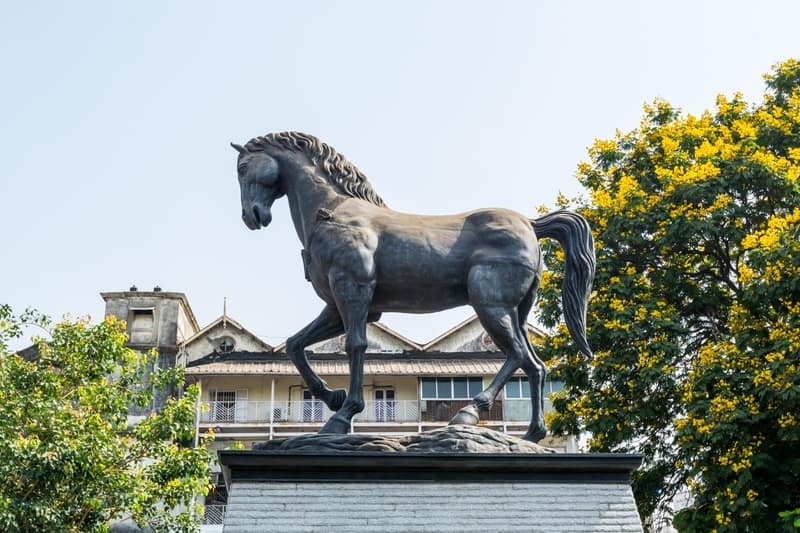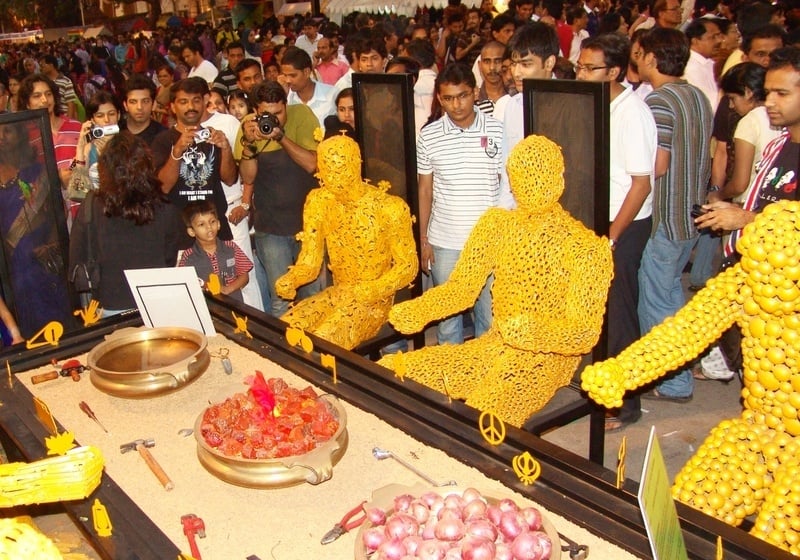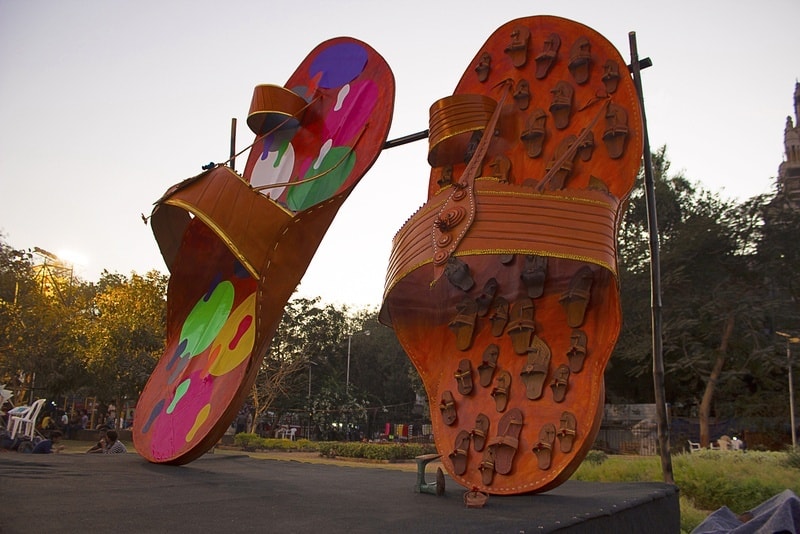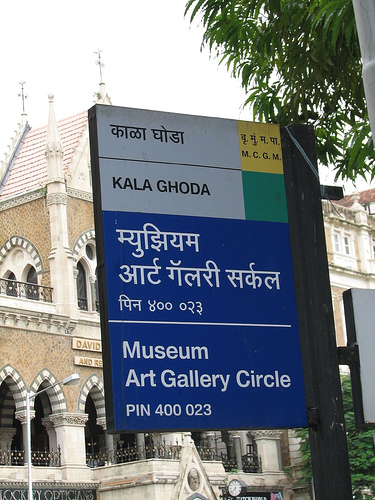A trendy, artistic neighborhood packed with designer cafés, independent galleries, and sidewalk art sellers.
The Jehangir Art Gallery and the National Gallery of Modern Art present modern visual arts. At the same time, the Chhatrapati Shivaji Maharaj Vastu Sangrahalaya museum displays a combination of history and art exhibitions.
The annual Kala Ghoda Arts Festival is well-known for its avant-garde installations, performances, and debates.
Let’s learn more about Mumbai’s art capital.
HISTORY OF KALA GHODA
The Kala Ghoda precinct is broadly described as the region extending from the Regal Circle at the southern end of Mahatma Gandhi Road to the Bombay University on the northern end, bounded to the west by the Oval Maidan to the east by the Lion Gate.

Kala Ghoda derives from the historic equestrian monument of King Edward Vll, which stood in the center of the vast junction on the old Esplanade Road.
The statue, a relic of the colonial past, has since been removed from the location, but the name remains a resounding affirmation of a powerful public memory.
KALA GHODA STATUE and ITS HISTORY
Time travel back to the mid-nineteenth century when the Prince of Wales (later King Edward VII) ruled over this renowned road in Bombay, and we’ll see how things have changed.
Sir Albert Abdullah David Sassoon, a descendant of the Sassoon family, one of Bombay’s founding families, gave the Kala Ghoda sculpture to the city.
Sir Joseph Boehm, a well-known London artist, created the statue. It was unveiled on June 29, 1879, by the then-Governor of Bombay, Sir Richard Temple.
A sculpture depicting the prince astride a horse set on a tall pedestal, dressed in military garb and holding a sword, was installed at the intersection of D N Road, M G Road, and Rampart Row. Significantly, the bronze sculpture was polished to a black sheen, ‘The Black Horse, or Kala Ghoda.’
The magnificent Kala Ghoda and its imperious rider symbolized imperial authority, towering above India’s ancient thoroughfare.
During the 1960s, it was thought that having a British monarch in such a prominent place in the newly independent country’s financial center was not good for India’s nationalistic spirit. The sculpture was moved to the Veermata Jijabai Bhosale Udyan, commonly known as the Byculla Zoo, in 1965.
Even though the Kala Ghoda was no longer physically present, its spirit remained and gave its name to the Fort Precinct.
Finally, in 2017, the precinct’s inhabitants and stakeholders agreed to give the neighborhood a new mascot. They couldn’t resurrect the old Kala Ghoda but needed something to represent the precinct and its name. ‘The Spirit of Kala Ghoda,’ a sculpture depicting a black horse without a rider.
This Black Horse, installed in January 2017, is located at the other end of the Kala Ghoda parking lot, just a few meters from the original artwork.

The Kala Ghoda Association (KGA), which organizes the annual Kala Ghoda Festival, donated the new sculpture. It is 25 feet tall and was created by sculptor Shreehari Bhosle and architect Alfaz Miller.
The KGA claims it did not wish to recreate or reproduce the original legislation, preferring to focus on the future. It would also function as a symbolic art piece against the backdrop of the arts festival.
KALA GHODA ARTS FESTIVAL
Since its inception in Mumbai in 1999, the Kala Ghoda Festival has increased in size and popularity, bringing tourists and other participants worldwide.
The Kala Ghoda Association organizes this Festival. This organization operates on a non-profit basis. The primary goal of this group is to establish the Kala Ghoda neighborhood as Mumbai’s Art District.
The Festival is divided into visual arts, dance, music, theater, film, and literature. Workshops, heritage walks, urban design, and architecture are all sub-sections.
There is also a section for youngsters. The lively street portion also features a stand offering eco-friendly and handcrafted items.
The Kala Ghoda Festival has grown in recent years. It is no longer limited to Kala Ghoda’s crescent; festivities are now hosted at Cross Maidan and Horniman Circle.
The Kala Ghoda Festival is an annual event on the first Sunday of February. This festival lasts nine days and concludes on the second Sunday in February. This event is held in the Kala Ghoda neighborhood of South Mumbai, India.
This is an ENTRY-FREE public arts festival open to all genres of programming. The Festival’s downloadable file will be available closer to the event dates on the website. A written guide will also be available at the HELP DESK during the event.
To download the file, go to https://kalaghodaassociation.com, select the ‘Festivals’ Menu, and select the ‘Sections’ submenu.
Submit an email to the KAGF’s relevant email addresses before September 1 if you wish to join the festivities. Each of the Kala Ghoda Association’s activities is described briefly below as contact information.

1. Children | kgaf@gmail.com
The Kala Ghoda Arts Festival will be a great event that caters to the requirements of children. It will also be about the child’s world, as the Kala Ghoda Association will offer over 60 entertaining and instructive events for youngsters.
Assure that your family and friends attend this enjoyable event, as numerous seminars and activities will be organized at the Museum of Chhatrapati Shivaji Maharaj Vastu Sangrahalaya over the nine days.
The organization intends to hold a range of courses and activities at Kitab Khana and Somaiya Bhavan, from literacy programs to indigenous language celebrations.
2. Cinema | kgaf@gmail.com
The Kala Ghoda Arts Festival will feature several unusual genre films, ranging from LGBTQ films to regional language films to quirky storylines, for all film fans.
Cinephiles would have suitable debates about movies and acting. Moreover, expect to witness your favorite actors gracing the stage for panel discussions and inspiring a devoted movie audience at the Kala Ghoda Arts Festival.
CSMVS’s Coomaraswamy Hall and Visitors’ Centre will be converted into mini-theatres.
3. Dance | kgaf@gmail.com
There will be more than 50 dancing events during the Kala Ghoda Arts Festival, so get your happy feet on.
The dance will have a one-of-a-kind theme, ranging from worldwide dance styles to Indian classical. Participate in dancing activities at Maidan Cross on Mahatma Gandhi Road, Churchgate.

4. Food | kgaf@gmail.com
Grab a filling meal because food usually wins at any festival or event. Exciting food walks and booths await you at this year’s Kala Ghoda Arts Festival.
Make sure you understand the significance of local products and cuisines. The culinary segment will strongly emphasize Mumbai-style cuisine and its components.
Discover what is making Indian cuisine more popular. Aside from that, it will be a gourmet adventure because many food stalls will teach you about various cuisines.
5. Heritage Walks | kgaf@gmail.com
The Kala Ghoda Arts Festival, organized by Heritage Walks, will educate locals about important historical sites in South Mumbai’s neighborhoods.
When learning about Mumbai’s rich cultural and architectural heritage, which is not yet well-known to tourists, the Kala Ghoda Arts Festival provides a historical bus tour that takes you back in time.
6. Literature| kgaf@gmail.com
This Kala Ghoda Arts Festival portion will undoubtedly get you pumped for the weekend. Book releases, poetry readings, and author discussions will highlight this portion of the Festival’s literature program.
Events in the field of literature will be conducted at the David Sassoon Library (DSL). If you consider yourself a bibliophile, you should attend the literature event at the Kala Ghoda Arts Festival.
There will be panel talks, book releases, and debates with well-known writers. This evening will be jam-packed with information for anyone interested in pursuing careers as authors, poets, or other creative endeavors.
7. Music | kgaf@gmail.com
You must see this segment of the Kala Ghoda Art Festival. The music performance will be an eye-opening spectacle, combining various aspects with genres ranging from classical Indian to English classical, Marathi classical, and even Sufi.
Several well-known musicians and singers will perform at the Cross Maidan event, while a few music events will occur at the Asiatic Library Steps.
You must attend the Kala Ghoda Arts Festival to enjoy a soulful music festival.
8. Stalls | kgafstalls18@gmail.com
Cheer up, all shoppers and foodies, for the Kala Ghoda Arts Festival stalls will be your continuous getaway.
You may happily shop till you drop from more than 100+ stalls. Many local artisans and craftsmen sell paintings, handcrafted purses, carpets, and other items.
Thousands of people go to the booths yearly to get first dibs on the merchandise. Stalls will be set up along Kala Ghoda and the traffic triangle near the Jehangir Art Gallery.
9. Street | kgaf@gmail.com
The Kala Ghoda Arts Festival was founded here on the street to entertain with a dash of art and culture.
The Street section is an extension of this concept, and it is here that local artists may express themselves. Artists from the West Zone Cultural Centre take the stage to entertain the spectators on Rampart Row.
Visitors to the event have been captivated by tiny, local performers on the vast stage that is Rampart Row, from kachi ghodi performances to folk puppet acts.

10. Stand Up Comedy | kgaf@gmail.com
You can enjoy some funny stand-up comedy at the Kala Ghoda Arts Festival. The Irish House on Dubash Marg performances will include new and veteran comedians.
Go ahead and laugh till you’re blue in the face.
11. Theatre | kgaf@gmail.com
Another event that blows your head at the Kala Ghoda Arts Festival is the theatre. Head for a fantastic theatre gathering in several languages, including Marathi, Hindi, English, Parsi, Gujarati, etc.
The event will be hosted at MC Ghia Hall (Kala Ghoda), the National Modern Art Gallery (NGMA), and the Horniman Circle Gardens.
You can’t afford to miss this exhilarating event, so be there if you consider yourself a true blue theater enthusiast.
12. Urban Design & Architecture | kgaf@gmail.com
Don’t miss the Urban Design and Architecture event at the Kala Ghoda Art Festival. There will be a meeting of inventive minds who will chat and discuss interview hacks and manifesting strategies per current world seniors.
So, serious creatives, don’t miss out on this at Max Mueller Bhavan.
13. Visual Arts | kgaf@gmail.com
The Kala Ghoda Arts Festival 2021, which takes place in February and celebrates the next era of innovation, focuses on indoor and outdoor visual arts works.
Visitors will be astounded by the art installations at Horniman Circle Garden, Cross Maidan, the Artists Centre on K Dubash Marg, and the Army-Navy Building’s Art Entrance.
Many creative items will blow your mind, from paintings to drawings to nature art.
14. Workshops | kgaf@gmail.com
Workshops, an indeterminate word that includes gems from the worlds of art, music, cinema, dance, literature, photography, fitness, cartooning, and much more, is like the proverbial salt: simple, modest, and discreet, but if you miss it, you miss the Festival’s flavors.
Workshops help adults and children acquire new skills and gain new information. It contributes to catapulting achievement to stratospheric heights. You will gain knowledge and abilities that will help you grow in life.
HOW TO REACH KALA GHODA
Nearest Airport
- Chhatrapati Shivaji Maharaj International Airport: 25Km
Nearest Railway Station
- Churchgate: 1.2 Km
- Chhatrapati Shivaji Maharaj Terminus: 1.7Km
Nearest Bus Station
- Colaba Bus Station: 2.8Km
Nearest Ferry
- Gateway Of India Ferry Terminal: 1Km
- Colaba: 1Km
Railway Station
Those in Mumbai’s outskirts can take a local train to the Chhatrapati Shivaji Terminus station or the Churchgate station (the closest rail station to the Gateway).
Trains run between Virar and Churchgate (Western Line), Karjat/Kasara and CST (Central Line), and Panvel and CST (Central Line) (Harbour Line).
Take a cab from either Churchgate or CST to get to the destination. You may even stroll the entire road to see additional British-era structures on your approach to the Gateway.
If you are in south Mumbai, take a cab or the BEST bus to your destination. Kala Ghoda is served by the following bus lines: 124, 133, 14, 22 LTD, 51, 83, 87 LTD, A-101, and A-51.
Board a ferry if you want to make your visit even more memorable. The panoramic view of the Gateway, the Taj in the background, and the river in front will capture your attention. You can reach Kala Ghoda by walking along the beautiful alleys from the jetty.

BEST PLACE TO EAT – Restaurants in Kala Ghada
Bombay Blue
Indian, Italian, and Mexican menus and other dishes are available at this restaurant chain’s Fort-side location, ideal for a lunch meeting and a post-work supper. (K Dubash Marg- 022 22041661)
Don’t miss the art on the walls or the massive salads at one of the area’s first restaurants. (Ropewalk Lane; 022 2265 0195)
This artfully designed “eggetarian” spot is fantastic for breakfast and offers an innovative menu that keeps regulars returning. So give the salli eggs, a Parsi specialty, a try. (VB Gandhi Marg; 022 2284 2430)
Ayub’s
Line your stomach or find carbohydrates to soak up the wine at this unassuming eatery known for its Kathi rolls and kebabs. Gurda (liver) and bheja (brain) fries are not for the faint of heart. (VB Gandhi Marg;+91 9821199147; opens at 6 pm)
Trishna
It would be best to visit this establishment to eat seafood prepared in the traditional methods. It is the best seafood restaurant in the city. (Ropewalk Lane; 022 2270 3214)
THINGS TO DO at Kala Ghoda:
The Kala Ghoda Art Precinct is located in Mumbai’s Fort, one of the city’s trendiest districts. It runs north along Mahatma Gandhi (MG) Road from Regal Circle (SP Mukherjee Chowk) to Mumbai University.
Experience The Rich Bygone Days & Heritage Buildings
The iconic structure was built particularly for a museum and opened to the public in 1922. Its Indo-Saracenic architecture illustrates the evolution of Mumbai’s older Gothic style.
The museum focuses on art and history and has about 50,000 objects in its collection (many excavated from ancient Indus Valley Civilization sites dating back to about 2000 BC).
It also hosts special-themed exhibitions regularly. The entry fee is Rs. 100 for Indians and Rs. 650 for visitors.
- Chhatrapati Shivaji Maharaj Vastu Sangrahalaya
- Elphinstone College
- Keneseth Eliyahoo Synagogue
- David Sassoon Library and Reading Room
Be creative in Kala Ghoda
As Mumbai’s art district, visiting Kala Ghoda would be incomplete without seeing the magnificent galleries. Fort contains a lot of art, which is excellent for individuals who enjoy discovering new artists.
One may go to curated stores, and art galleries or go down the street to see art displays! We also like that we get free admission to the art galleries here. They promote expression and are happy to welcome anybody who enjoys art.
The majority of these art galleries regularly host exhibitions for people to enjoy. You may spend the day going to galleries and seeing a variety of various styles of art.
- Jehangir Art Gallery
- Jehangir Nicholson Art Foundation
- Museum Gallery
- Kala Ghoda Pavement Gallery

You Can Shop Until You Drop
In addition to art galleries, Kala Ghoda boasts a plethora of shopping alternatives to entice any shopper. Vintage vinyl records, blingy accessories, designer boutiques, sustainable fashion stores, and street stalls offering stylish casual clothes, musical instruments, phone accessories, books, purses, and sunglasses are all available.
Bargain Book Hut has fantastic bookworm discounts, and art enthusiasts will love the exquisite masterpieces in inexpensive artwork.
- Valliyan & Masaba
- Sabyasachi Couture
- DayDREAM Art Gallary
- Wayword & Wise
Visit Historic Restaurants for a Delicious Meal
During the period of British administration, the Fort area drew migrants from diverse communities in India, notable adherents of the Zoroastrian religion who had escaped persecution in Persia and Iran.
They established themselves in the crowded Bora Bazaar neighborhood at the northern end of Fort, forming their separate microcosm.
- Yazdani Bakery
- Britannia & Co
- Jimmy Boy
- Cafe Excelsior

Leave a Reply